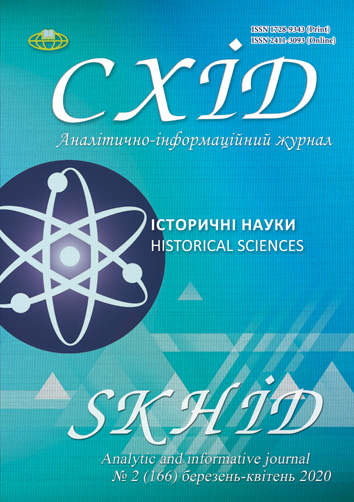The radio propaganda as an innovative element of the military tactics and strategies of the Nazi Germany 1933-1941
DOI:
https://doi.org/10.21847/1728-9343.2020.2(166).201722Keywords:
radio, radio war, information space of Nazi Germany, media, propagandaAbstract
The role of radio as one of the parts of the Nazi information space, formed in Europe before and at the beginning of the Second World War, is revealed. Radio propaganda is presented as an integral element of Nazi Germany's military tactics and strategy, which became important in the psychological treatment of the population before the hostilities. Spreading radio broadcasting to foreign countries by Nazi authorities, ambitions to gain popularity that would allow it to compete with the media of England, France, the United States of America and the USSR, and radio broadcasts from foreign countries, were considered. Almost all Nazi propaganda programs were targeted primarily at the occupied territories. Significant role was played by the programs that promoted Germany's great mission. Having secured a European radio space, Hitler's propaganda headquarters began a true radio war in the East Europe. The purpose of the article is to expose radio propaganda as one of the parts of the information space that Hitler's authority sought to form in the occupied territories of Eastern Europe. The article analyzes the state of scientific development of the problem in domestic and foreign historiography. The basic approaches to the research of the problem and the methods of research of the content of radio transmissions, their influence on the population of Germany in the 1930s of the XX century are determined. The scientific novelty of the presented research is the demonstration of radio propaganda as an integral element of Nazi Germany's military tactics and strategy. The outlined research period is 1933-1941, which explained by the fact that the Nazi authority, spreading radio broadcasting to foreign countries, sought to gain popularity that would allow it to compete with the media of England, France, the United States of America, Austria and the USSR. Almost all Nazi propaganda programs focused primarily on the consolidation of ethnic Germans abroad. Research confirmed that already during the German-Soviet War, technological advances in radio broadcasting were used not only by the Nazi authority, but also by the authorities of England, the United States and the USSR. German radio propaganda was carried out using specially developed techniques and methods. Among them are: official announcements in which good news were reported in detail, unprofitable - superficial; the repetition of the enemy's official announcements between information news which had a certain propaganda purpose - to undermine the belief in the success of the enemy's action; sensational broadcasts that focused on one important propaganda topic or event; the broadcasting of completely falsified material, that is, fictitious, that the listeners could not immediately understand truth; official radio programs forged with reference to fictitious sources were broadcast, as well as broadcasts based on a source of information secretly controlled by Germany.Downloads
References
Entsiklopediya Tretego Reykha (1996). Moscow: Lokid-Mif, 582 s.
Goody, A. (2018). BBC features, radio voices and the propaganda of war 1939-1941. Media History, 24(2), 194-211. DOI: https://doi.org/10.1080/13688804.2018.1471346.
Jang, H.-K. (2020). Cultural policy and propaganda film in the Third Reich. [독일 제3제국의 문화예술정책과 선전영화]. Humanities Studies East and West, 58, 221-252.
Jenemann, D. (2019). Propaganda and Preservation: Missed Opportunities and Inadvertent Archives in Radio Research. Journal of Radio & Audio Media, 26(1), 35-49. DOI: https://doi.org/10.1080/19376529.2019.1564992
Jowett, G. S., O’Donell, V. (1992). Propaganda and Persuasion. Newbury Park etc. Stuttgart, 240 р.
Okorokov, A. (2007). Osobyy front. Nemetskaya propaganda na Vostochnom fronte v gody Vtoroy mirovoy voyny. Moscow: Russkiy put, 288 s. (In Russian)
Panfilov, A. F. (1984). Radiovoyna: istoriya i sovremennost. Retrieved from https://sheba.spb.ru/za/radio-voina-1984.htm (In Russian)
Petrov, V. L. & Sholokhov, S. N. & Snegurov, A. V. (2001). Primenenie neyrofiziologicheskoy kontseptsii intellektualnoy deyatelnosti cheloveka dlya modelirovaniya slozhnykh sistem upravleniya - obektov informatsionnogo protivoborstva. Zbіrnik naukovikh prats. Issue 4(34). 60-66. (In Russian)
Radioveshchanie v Tretem Reykhe (2019). Retrieved from http://mirslovarei.com/content_his/RADIOVESHHANIE-V-TRETEM-REJXE-52288.html (In Russian)
Sharikov, A. (2008). Politicheskoe radio cherez prizmu istorii. Broadcasting. Televidenie i radioveshchanie. 3, Retrieved from http://broadcasting.ru/articles2/humanit/history-radio (In Russian)
Shirer, Uilyam (1991). Vzlet i padenie tretego reykha. Moscow: Voenizdat, Vol. 1. 653 s. (In Russian)
Slutsch, S., & Tischler, C. (2018). NIMECHCHYNA I SVITEYSKYY SOYUZ 1933-1941 rr. Dokumenty z rosiyskykh ta nimetskykh arkhiviv. Vol.2, Sichen 1935 - kviten 1937. Vierteljahrshefte Für Zeitgeschichte, 66 (4), 576- + (In Ukrainian).
Tytarenko, D. (2018). National Socialist Propaganda in the Ukraine Military Administration Area Aims, Means, and Effects. Jahrbucher Für Geschichte Osteuropas, 66(4), 620-650. DOI: https://doi.org/10.25162/jgo-2018-0019
Yudenkov, A. F. (1971). Politicheskaya rabota sredi naseleniya okkupirovannykh sovetskikh territoriya 1941-1944. Moscow, 380 s. (In Russian)
Zholkver-Krasnopolskaya, V. (2007). Radio policy and radio propaganda in the Third Reich. Retrieved from http://209.85.129.132/search?q=cache-PointoaoxU1ynaAJ:www.radioscanner.ru/info/article
Downloads
Published
How to Cite
Issue
Section
License
Copyright (c) 2020 Oksana Salata

This work is licensed under a Creative Commons Attribution-NonCommercial-NoDerivatives 4.0 International License.
1. Authors bear responsibility for the accuracy of facts, quotations, numbers and names used.
2. Manuscripts are not sent back.
3. The publisher does not always agree with the authors' opinion.
4. The authors reserve the right to authorship of the work and pass the first publication right of this work to the journal under the terms of a Attribution-NonCommercial-NoDerivatives 4.0 International, which allows others to freely distribute the published research with the obligatory reference to the authors of the original work and the first publication of the work in this journal.
5. The authors have the right to conclude separate supplement agreements that relate to non-exclusive work distribution in the form in which it has been published by the journal (for example, to upload the work to the online storage of the journal or publish it as part of a monograph), provided that the reference to the first publication of the work in this journal is included.

